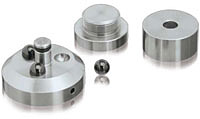Yo Dudes,
As you know I am experimenting with my audio rack.
Last time I had shared with you the controversy article about nordost spikes.
That article brought my attention to the fact that anything you put under your equipment will influence the sound.
I also have changed my mind regarding soft connections. I understood that the energy that is produced within electronics and which is delivered to them through the speaker cables is the most important issue to cope with.
Cope means to make very solid connection so energy can go away. Which materials and how to mineralize the vibrations still stays magic for me, but let’s say that ceramic balls and rvs/alu is the destiny!
Anyway I have build something based on new knowledge and it seems to work.
The frame of the rack is filled with the quartz sand, that poses a great resonance value.
Feet are equipped with super spikes! (just to start somwhere)
Special, just a spikes, but they allow proper solidity and adjustability.
The whole rack stands very, very solid and there is no way of footsteps trilling. The whole thing weights app. 95kg. Maybe Adrian can count how much tons of weight is on the point of each spike.
The rest stays basically the same as in the past. (Position of the cd player is just for a test reason. I want to determine, if I still audible the spinning of cd, by some quiet moments)
The verdict:
I hear the change! I can´t say what is it exactly though it is different. I got the feeling that I can listening with harder volume before having a bass problem.
Though I think that the stage has lowered itself.
The next step:
- I try to find out which material is the best to use as an equipment platform (plexi, glass, granit)
- I am trying to find out how much it would be to make base stands as shown above from finite elemente: http://www.finite-elemente.de/en/accessories/cerafamily/cerabase_compact
- The ceramic balls are chosen and can be bought cheap in Poland for1.5E
What you think?



Audio Component and Turntable Isolation & Damping Explained:
BeantwoordenVerwijderenProspective buyers of audio/video vibration control products for should know the basic definitions of, and the distinctions between ISOLATION and DAMPING to enable them to make informed purchases.
A Vibration ISOLATOR is a viscoelastic part or a device that provides relative movement between the supported component or loudspeaker and the supporting structure, ie: the rack, a platform or the floor.
A Vibration DAMPER is a viscoelastic material or a device that converts vibratory energy into heat - thereby dissipating the vibratory energy.
In an automobile, the springs provide isolation and the shocks provide damping but they are not interchangeable! They are interdependant!
FOR AUDIO / VIDEO, THE BEST PRODUCTS ARE THOSE THAT PROVIDE ISOLATION AND DAMPING!
ISOLATION refers to the process of preventing (minimizing) externally generated vibratory energy from reaching a structure or component. Although this includes acoustic or air-borne vibration that is difficult to manage in exposed audio/video equipment, we are primarily concerned with the transfer of mechanical vibration. And, it is essential to understand that there is no significant mechanical isolation provided unless there is relative movement between the component or loudspeaker and its supporting structure to minimize sympathetic movement with the supporting structure. Therefore, only a device or material that can compress like a spring or deform like an air-bag or a viscoelastic part, or “roll” like a bearing, can be an isolator. Exceptions to these “passive” examples include “active” systems that have electromechanical capabilities. Obviously, hard “spikes”, "cones", and (bare) "platforms" or "shelves" are not vibration isolators regardless of their material composition! However, a platform supported by isolators as part of its design can be an isolation platform.
DAMPING is the dissipation of energy in an vibrating structure or component. It refers to the process of removing (minimizing) internally generated vibration that is inherent in a component AND any external vibration that, for lack of adequate isolation may enter the component, by converting the mechanical vibratory energy of solids into heat energy - a process called hysteresis. Vibration damping is generally accomplished by the bonding of viscoelastic materials to the (vibrating) internal surfaces, mechanisms and parts of a component and by external coupling to viscoelastic materials or damping devices.
Hi Andre,
BeantwoordenVerwijderenLooks good man. How much did the superspikes cost?
I spend last evening hammering wooden wedges between the floorbeams and masonry pedestals.
Not sure if anything changed but it was fun.
Best regards,
Adriaan
Adri,
BeantwoordenVerwijderenThe spikes were not to cheap, around 45€, but you can count on these from me if I manage to go further with my project.
I must come to you to listen...
Greetings